HP OpenVMS Systems Documentation |
DECwindows Motif for OpenVMS Applications Guide
Displaying PostScript FilesMail can display POSTSCRIPT files, provided the files you send or receive contain only POSTSCRIPT language. A POSTSCRIPT file always begins with a percent sign and an exclamation point (%!). If any other text precedes the %!, Mail cannot display the file. For example, when you forward mail, additional text (in the form of extra mail headers) is often inserted at the beginning of the file. Because this additional text precedes the %!, Mail cannot display the POSTSCRIPT file correctly. To make sure a POSTSCRIPT file does not contain any text preceding the %!, use an editor to remove all headers before you forward a mail message in POSTSCRIPT format:
Similarly, if you receive a POSTSCRIPT file that does not display properly, use an editor to remove all headers (or any other text that precedes the %!), and forward the file to yourself. If a POSTSCRIPT file does not contain the %! at the beginning of the file, you can use the same procedure to add it. The POSTSCRIPT file should then be displayed properly. Customizing Your Mail Environment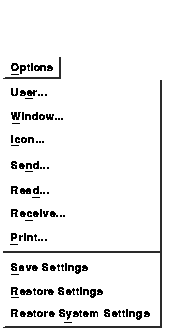
You can customize many Mail features to suit your working environment. You can alter your Mail user profile, your DECwindows environment, the way your Mail icon is displayed, and the options that control the way your messages are sent, stored, displayed, and printed. The Options menu in the main window lists the types of options that you can change. Each category of options has a corresponding dialog box in which you choose the changes you want to make. In each of the dialog boxes, an option is enabled when its button is shaded. To enable or disable an option, click on the corresponding button or its label. The following sections list and describe the Mail options you can change.
Modifying Your User OptionsTo change the default settings for your Mail User options, choose User... from the main window's Options menu. Mail displays a dialog box. 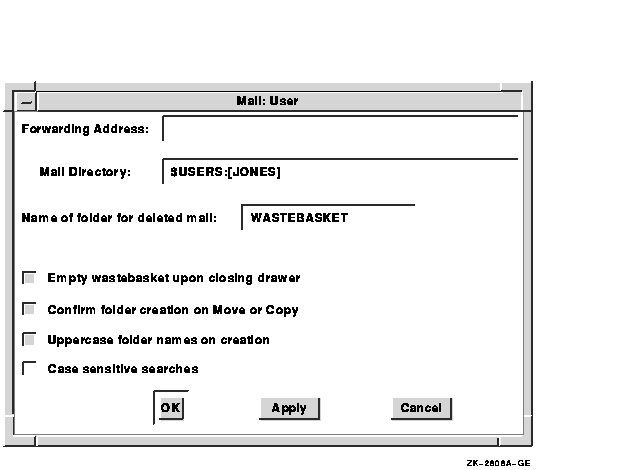
The following table describes the options in the User dialog box.
Click on the OK or Apply button to save the profile settings for the current session only. To save the settings permanently, choose Save Settings from the main window's Options menu. Click on the Cancel button to reinstate the original profile settings. Modifying Your Window OptionsModifying your window options allows you to choose the main window style, the color of each type of window you work with (the main window, Read window, Create--Send window, dialog boxes, and message boxes), and whether Mail starts as an icon or as a window. To change the default settings for your DECwindows environment, choose Windows... from the main window's Options menu. Mail displays a dialog box. The following illustration shows the Window options dialog box as it appears on a color system; there are slight differences in the Window options dialog box on a black-and-white system. 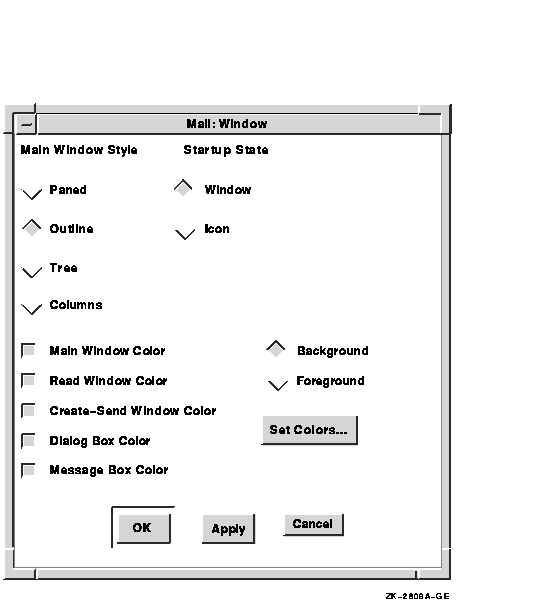
The following table describes the options in the Window dialog box. Some options apply to color systems, others apply to black-and-white systems. The options that do not apply to your system do not appear in your Window dialog box.
You can change among the main window styles Outline, Tree, and Columns simply by clicking on OK or Apply. Changing from one of those window styles to the Paned style (or from the Paned style to another style window) does not take effect until you choose Save Settings from the Options menu and then exit and reenter Mail. The colors you choose for Main Window Color, Read Window Color, Create--Send Window Color, Dialog Box Color, and Message Box Color affect future windows you create, not those already in existence. The color changes are applied to the types of windows that are enabled when you select the colors. Initially, all windows are enabled. Modifying Your Icon OptionsYou can modify your icon options to customize the text displayed in the DECwindows Mail icon in the icon box. You can also control whether the number of new messages is displayed in the icon. To change the default settings for your Mail icon, choose Icon... from the main window's Options menu. Mail displays a dialog box. 
The Number of New Messages option controls whether Mail displays in the Mail icon the number of new (unread) messages. By default, this option is enabled. If you do not want Mail to display the number of new messages in the Mail icon, disable this option. The two text entry boxes in the upper left and upper right corners of the Icon dialog box allow you to customize the text that appears in the Mail icon. The text in these boxes is displayed before and after the number of unread messages in the Mail icon. By default, the text that appears in the left text entry box is Mail, and the right text entry box is blank. To add or change text in either text entry box, click MB1 on the appropriate box and enter the text you want to be displayed. Click on the OK or Apply button to save the profile settings for the current session only. To save the settings permanently, choose Save Settings from the main window's Options menu. Click on the Cancel button to reinstate the original profile settings. Modifying Your Send OptionsTo change the default settings for mail messages that you send, choose Send... from the main window's Options menu. Mail displays a dialog box. 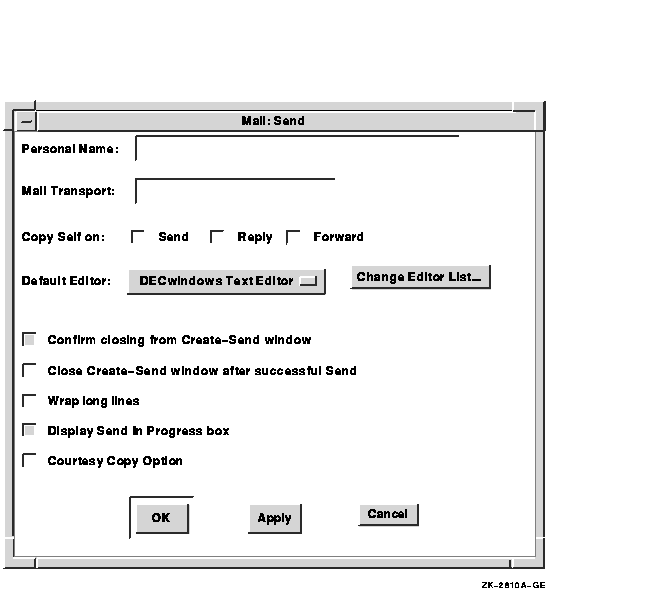
The following table describes the options in the Send dialog box.
Changing the Editor ListTo add a new editor to the list of available editors that you can use to create and edit messages:
Modifying Your Read OptionsRead options specify the action that Mail automatically takes on the Read window after you delete or move the current message. To change the default settings, choose Read... from the main window's Options menu. Mail displays a dialog box. 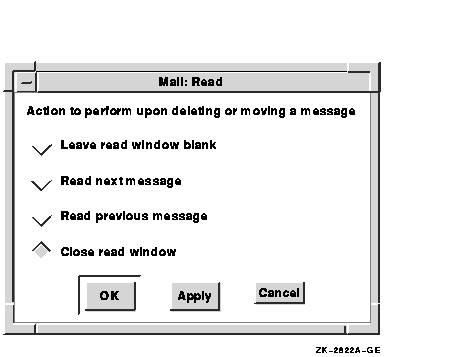
Leave Read Window Blank causes the Read window to be left blank. This is the default. Read Next Message causes the next message in the folder to be displayed automatically in the Read window. Read Previous Message causes the previous message in the folder to be displayed automatically in the Read window. Close Read Window causes the Read window to be closed. Modifying Your Receive OptionsTo change the default settings for mail messages that you receive, choose Receive... from the main window's Options menu. Mail displays a dialog box. 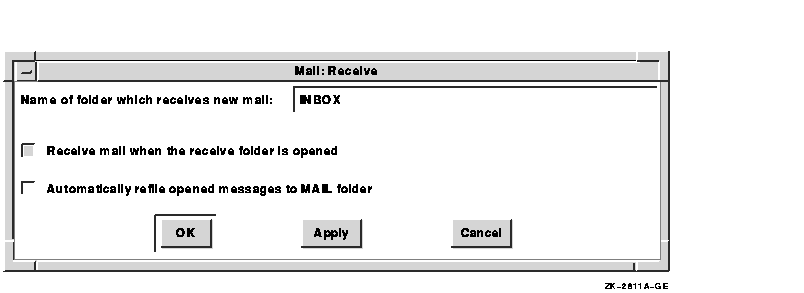
The following table describes the options in the Receive dialog box.
Changes made to the Name of Folder Which Receives New Mail option do not take effect until you choose Save Settings from the Options Menu and then exit and reenter Mail. Modifying Your Default Print SettingsYou can modify your default print settings to alter the way your messages are printed. To modify your default print settings, choose Print... from the main window's Options menu. Mail displays a dialog box. 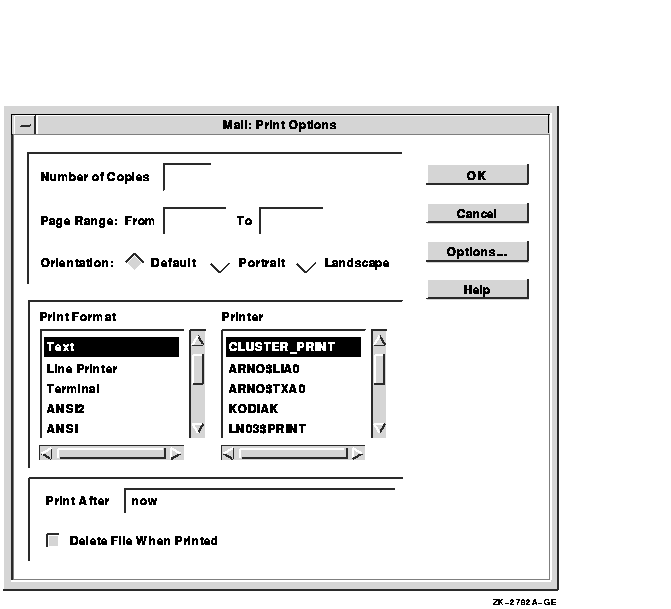
Refer to Using DECwindows Motif for OpenVMS for a description of the options in this dialog box. Changing your print defaults affects the way messages are printed during the current Mail session only. When you exit Mail, any print defaults you have changed revert to their original settings. Saving and Restoring SettingsIf you have changed the size or position of the windows or any other user options except print settings, you can save these changes permanently. After you have made the desired changes, choose Save Settings from the main window's Options menu. If you do not save the changes now, Mail asks you whether to save the changes when you exit Mail. Print settings are not saved. To restore changed settings to the last saved settings, choose Restore Settings from the main window's Options menu. To restore your settings to the system defaults, choose Restore System Settings from the main window's Options menu. Making Mail Perform Like the OpenVMS Mail UtilityIf you use both the OpenVMS Mail utility and DECwindows Mail to access the same mail messages, Mail automatically sets certain options in your mail profile to make DECwindows Mail perform like OpenVMS Mail. DECwindows Mail automatically sets the following options in your mail profile:
Set the remaining options to match your OpenVMS Mail settings. See Customizing Your Mail Environment for more information on modifying your DECwindows Mail options. Once you have set these options, you will find that using DECwindows Mail is very similar to using OpenVMS Mail. Mail provides most OpenVMS Mail functions with the exception of SPAWN, ATTACH, EDIT, and DEFINE/KEY. These functions are unnecessary in the DECwindows Motif for OpenVMS environment. Using Alternative Main Window StylesMail's default main window displays your drawers, folders, and messages in Outline style. When you open an object, its contents are revealed directly beneath it, similar to the format of a table of contents. You can choose an alternative style for displaying the objects in your main window. The other styles are Columns, Tree, and Paned. The Columns style main window is similar to the Outline style except that the window is divided into two panes. The right pane can be scrolled vertically. Each pane can be scrolled horizontally independently of the other. Horizontal scrolling allows you to read a long subject line of a message while still being able to view the message number, date, and so on. The Tree style main window displays your file cabinet hierarchy as a graphical tree. A Paned style main window uses two horizontal panes to display your drawers, folders, and messages. The top pane lists your folders or drawers. The bottom pane lists the messages in the open folder. To change to a different main window style, choose Window... from the Options menu. Choose one of the window styles listed in the Window dialog box. Changing among the Outline, Tree, and Columns style windows takes effect immediately. Changing to the Paned style main window from a different style window---or changing from the Paned main window to a different style--- takes effect when you choose Save Settings from the Options menu, and then exit and reenter Mail. In a Paned style main window, the names of your folders are always displayed, regardless of the number of messages in the open folder. (In Outline style, opening a folder frequently fills the window with the contents of that folder, pushing all other drawer and folder names out of the display.) Having folder names readily available is useful for certain Mail functions, such as moving and copying messages. 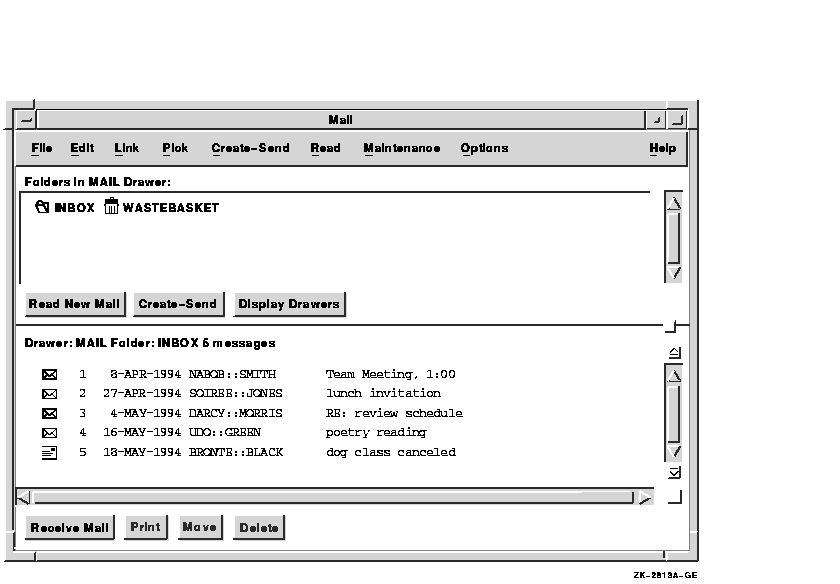
The Paned style main window differs from the other window styles in the following ways:
|